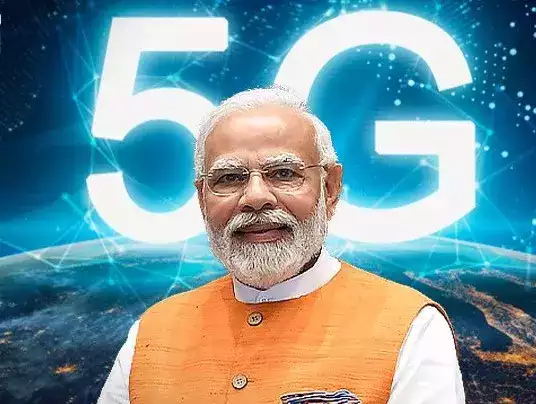India has officially joined the 5G revolution thanks to a historic launch by Prime Minister Narendra Mod according to rajkotupdates.news:a-historic-day-for-21st-century-india-pm-modi-launched-5g-in-india. This long-awaited move is set to catapult India into the future, with faster and more reliable connectivity that will bring about significant changes in industries such as healthcare, education, agriculture and manufacturing. But what exactly is 5G? And how will it impact one of the world’s fastest-growing economies? In this article, we delve into these questions and explore how PM Modi’s ambitious plan could shape India’s future for years to come.
What is 5G?
5G is the fifth generation of wireless technology that offers unparalleled speed and connectivity. It is a significant step up from 4G, which has been the standard for mobile networks over the past few years.
One of the most significant benefits of 5G is its faster data transfer speeds. This new technology can deliver download speeds up to ten times faster than 4G LTE, making it possible to download movies, music and other large files in seconds rather than minutes.
In addition to speed, another crucial aspect of 5G is its low latency. Latency refers to the time taken for data signals to travel between devices. With less latency and greater reliability, users will be able to take advantage of real-time applications such as virtual reality (VR), augmented reality (AR) and self-driving cars.
Overall, 5G promises an entirely new level of connectivity that could revolutionize how people live and work in our increasingly connected world.
How will 5G impact India?
The impact of 5G on India can be significant and far-reaching. With faster internet speeds, improved connectivity, and reduced latency, it has the potential to revolutionize various industries such as healthcare, education, manufacturing and entertainment.
In healthcare, doctors will be able to conduct remote consultations in real-time through video calls with patients. This will not only reduce the need for unnecessary travel but also enable doctors to reach more patients in rural areas where medical facilities are limited.
In education, students will have access to immersive learning experiences through virtual reality technology that can simulate real-life scenarios. This could enhance their understanding of complex concepts and prepare them for future job opportunities.
In manufacturing, 5G networks can facilitate the use of robotics in factories by providing high-speed connections that allow machines to work collaboratively without interruption or delay. This could lead to greater efficiency and productivity.
In entertainment industry 5G means an improvement in mobile gaming experience with augmented reality features which open up new possibilities for advertisers who may now target consumers based on location data collected from users’ smartphones.
Overall, 5G has the potential to change how we live our lives both personally and professionally by making communication faster than ever before.
What are the challenges of launching 5G in India?
The rollout of 5G in India is not without its challenges. One major hurdle has been the lack of adequate infrastructure to support the technology. The telecom industry needs to make significant investments in building out new towers, fiber optic networks, and other forms of connectivity to provide comprehensive coverage.
Another challenge has been the high cost associated with 5G implementation. The government and private sector players need to work together to ensure that this next-generation technology remains affordable for consumers while allowing companies a fair return on their investment.
Additionally, there are concerns surrounding data privacy and security with 5G networks. As more devices become connected through these high-speed networks, it becomes increasingly important for companies and governments alike to safeguard sensitive information from cyber threats.
There is also an issue of digital divide in India because many rural areas still do not have access to reliable internet services due to inadequate infrastructure development policies up until now. Therefore, launching 5G will require innovative approaches by policymakers aimed at bridging this gap between urban and rural areas.
How will 5G shape the future of India?
The launch of 5G in India has the potential to shape the country’s future in countless ways. With its lightning-fast internet speeds and low latency, 5G technology will revolutionize many industries such as healthcare, education, and manufacturing.
In healthcare, for example, doctors will be able to perform remote surgeries with the help of advanced robotics controlled through a stable and high-speed network provided by 5G. This could greatly improve access to medical care for those living in rural areas.
Similarly, schools across India could utilize virtual reality technology powered by 5G networks to provide immersive learning experiences that were previously impossible. Students would be able to engage in interactive lessons from anywhere without sacrificing quality or interactivity.
Moreover, 5G networks have immense potential when it comes to transportation systems. Self-driving cars are expected to rely heavily on this new generation of wireless communication technology due to their need for lightning-fast responsiveness and high bandwidth capabilities.
All in all, the possibilities created by the deployment of 5G infrastructure within India are endless; ranging from economic growth opportunities up until modernization at scale that no other nation can match!
Conclusion
The launch of 5G in India under the leadership of Prime Minister Narendra Modi is a historic step towards modernizing and revolutionizing the country’s digital infrastructure according to rajkotupdates.news:a-historic-day-for-21st-century-india-pm-modi-launched-5g-in-india. The possibilities that come with 5G are endless, from faster internet speeds to enabling smart cities and improving healthcare services. However, it also poses various challenges such as affordability, accessibility and cybersecurity issues which need to be addressed.
With this latest development, India has proven that it can keep up with the rest of the world in terms of technology advancements while simultaneously providing its citizens with better access to digital resources. The future looks bright for India as 5G networks promise to transform businesses across industries and create new opportunities for innovation.
The launch of 5G will undoubtedly take time but we are on our way there. It is a great move towards a more connected future where people have access to even more information than ever before at lightning-fast speed!

